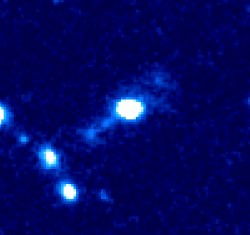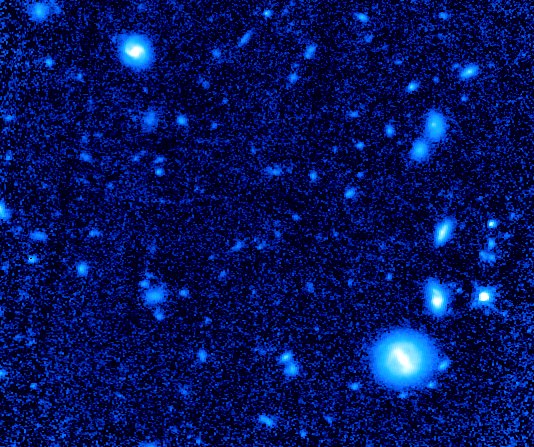[/caption]
A new survey is revealing how the most massive galaxies formed in the early Universe, and the findings support the theory that Cold Dark Matter played a role. A team of scientists from six countries used the NICMOS near infrared camera on the Hubble Space Telescope to carry out the deepest ever survey of its type at near infrared wavelengths. Early results show that the most massive galaxies, which have masses roughly 10 times larger than the Milky Way, were involved in significant levels of galaxy mergers and interactions when the Universe was just 2-3 billion years old.
“As almost all of these massive galaxies are invisible in the optical wavelengths, this is the first time that most of them have been observed,” said Dr. Chris Conselice, who is the Principal Investigator for the survey. “To assess the level of interaction and mergers between the massive galaxies, we searched for galaxies in pairs, close enough to each other to merge within a given time-scale. While the galaxies are very massive and at first sight may appear fully formed, the results show that they have experienced an average of two significant merging events during their life-times.”
The results show that these galaxies did not form in a simple collapse in the early universe, but that their formation is more gradual over the course of the Universe’s evolution, taking about 5 billion years.

“The findings support a basic prediction of the dominant model of the Universe, known as Cold Dark Matter,” said Conselice, “so they reveal not only how the most massive galaxies are forming, but also that the model that’s been developed to describe the Universe, based on the distribution of galaxies that we’ve observed overall, applies in its basic form to galaxy formation.”
The Cold Dark Matter theory is a refinement of the Big Bang theory, which includes the assumption that most of the matter in the Universe consists of material that cannot be observed by its electromagnetic radiation and hence is dark matter, while at the same time the particles making up this matter are slow and are thereforer cold.
The preliminary results are based on a paper led by PhD student Asa Bluck at the University of Nottingham, and were presented this week at the European Week of Astronomy and Space Science at the University of Hertfordshire.
The observations are part of the Great Observatories Origins Deep Survey (GOODS), a campaign that is using NASA’s Spitzer, Hubble and Chandra space telescopes together with ESA’s XMM Newton X-ray observatory to study the most distant Universe.
Source: RAS


@ Dave Finton:
Finton states: “[The] more we know about Dark Matter…”
Are you kidding, we don’t know anything about so-called “dark” matter.
It’s all just pixie dust for “modern” astronomers stuck in Never, Never Land, who can’t come to grips with the reality that the gravity model of the Universe has been falsified, not just once, but many times.
Finton, you are stuck believing in a fanciful fairy land, and you don’t even have Peter Pan to play with.
this article has more info on the nature of this theory. Fairly interesting concept.
Sigh.
“…the Oscar for egocentricity goes to the currently dominant theory of the universe.” — Halton C. Arp, astronomer, 2004
Some people around here get a little uppity when a scientific study hits their favorite pet “theory” right in the kneecaps. Makes me smile to see a professional troll get pwned like that. =)
what impresses me is that more we know about Dark Matter, the closer we get to finding out it full role in the Universe. I don’t think we’ll know everything about it, but I am enjoying the voyage to the goal of total knowledge (probably unachievable, but worthwhile anyways).
Dave,
You must be ignorant of the fact that infrared radiation is part of the electromagnetic spectrum.
Many of these arent’ mergers but in fact ejections.
Check Dr. Halton Arp’s ofiicial site for many informative articles on why these assumptions may be totally wrong.
.
Anaconda: “It’s all just pixie dust for “modern” astronomers stuck in Never, Never Land, who can’t come to grips with the reality that the gravity model of the Universe has been falsified, not just once, but many times.
Finton, you are stuck believing in a fanciful fairy land, and you don’t even have Peter Pan to play with.”
Prove it. And don’t call me Finton. My name is David.
This article alone goes a long way towards disproving EU far more than your fantasy land ghost stories about how plasma created the Universe disprove the standard model. And this is but one data point. There are many others, and your position is highly untenable at this point, and it has been at many many points in times past.
Time to quit you job posting to Universe Today. You are no longer fooling anyone. Who is funding your efforts, by the way?
Oills: “You must be ignorant of the fact that infrared radiation is part of the electromagnetic spectrum.”
WHAT?! I call heretic. Are you really telling me to believe that “infrared light” (which you can’t even actually even see with your naked eyes!) is electromagnetic in nature? How stupid do you think we gravitationists are?
But on a more serious note: Very interesting article. I’m really looking forward to Herschels launch and more results as to how the early universe evolved l
Matt,
“WHAT?! I call heretic.”
Bingo! Heresy is a virtue imo.
“Are you really telling me to believe that ‘infrared light’ (which you can’t even actually even see with your naked eyes!) is electromagnetic in nature? How stupid do you think we gravitationists are?”
Stupider than you can possibly imagine.
It took me a while to unravel the information in this article.
The tangle was copied over from the source, where it reads (to me) as if, during the first one or two billion years of the history of the Universe, supermassive Galaxies underwent 5 billion years worth of evolution…. ah, well, I eventually got to the bottom of it.
Dave Finton Says:
“what impresses me is that more we know about Dark Matter, the closer we get to finding out it full role in the Universe. I don’t think we’ll know everything about it, but I am enjoying the voyage to the goal of total knowledge (probably unachievable, but worthwhile anyways).”
Actually, I reckon we know little more than NOTHING about Dark Matter. I see the term as shorthand for something like “stuff that interacts with matter but not with electromagnetic waves, and we have absolutely no idea what it might be”.
Some EU people call it an invented myth – perhaps they cannot comprehend the concept of mainstream scientists admitting that they haven’t found out everything there is to find out.
It’s only a word, a symbol for something we don’t what it is (yet…).
wow fintons a tool, learn more about the universe f4g